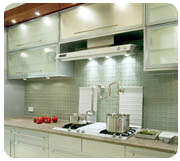
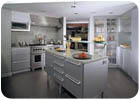
For a recent renovation of a private residence in Easton, CT, a unique seafoam green-colored natural quartzite was installed as countertops and tabletops in the kitchen. Architect: Charles M. Rabinovitch Architects, New York, NY; Stone Supplier: Stone Source, New York, NY; Tile Supplier: Studium
“It's very hard [selecting material],†said Rabinovitch. “There is a tendency or at least a temptation to try lots of things - to use them in a more random way. We try to resist that temptation and use appropriate material, rather than just trying to use something to be different.â€
But when given the opportunity to use a stone or tile that is unique, but also meets the function of the space, Rabinovitch rises to the occasion. For one recent project, the architect hunted for a specific shade and consistency of stone until he finally discovered a rare seafoam green-colored natural quartzite that met the specifications for a kitchen countertop. He joked that when he tried to use the stone again for another project, he learned it was no longer being quarried. “This is an example of how the material is different, but right for that setting,†said the architect, explaining that the quartzite is a very strong, durable material.
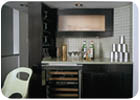
Further enhancing the kitchen design are the walls and backsplash, consisting of etched glass tiles that are each a little bigger than an inch square. “It is a beautiful balance with the green of the quartzite on the counters,†said Architect Charles Rabinovitch.
In general, Rabinovitch believes that the use of stone or tile in residential design has been on the rise in recent years. “It's almost assumed that you are going to use a stone,†he said. “It's just a question of which one. Certainly 10 years ago, people weren't always using stone.â€
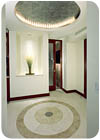
The entry of a luxurious Trump Tower residence in Manhattan features a stone centerpiece custom made from two varieties of Bulgarian limestone. Architect: Charles M. Rabinovitch Architects, New York, NY; Stone Supplier: Paris Ceramics; Stone Fabricator/Installer: Demiray Marble & Tile, New York, NY
A Modern-day Farmhouse
From the start of the redesign of a home in Easton, CT, which utilized the rare seafoam green-colored natural quartzite for the kitchen countertop and tabletops, Rabinovitch intended to use stone. “We knew that we wanted to use stone for reasons of durability and practicality,†explained the architect. “We were looking for a color with warmth, and green was a nice choice. The problem was that most of the green stones had a more traditional feeling. We were desperately looking for something to fit the bill.â€Rabinovitch went on to say that the residence - located in a rural farm community - is a country retreat for a New York couple. “The house is a kind of metamorphosized colonial farmhouse,†he said. “It started out as a barn house with a very country rural feeling. It had hand-hewn wooden beams. We wanted to add something starkly contemporary that was different from the rest of the house.â€
A priority of the renovation was the kitchen space, which initially had an inefficient layout that did not take advantage of the historical characteristics of the house nor its beautiful surroundings, explained the architect. “The assignment was to create a new, expanded, state-of-the-art kitchen area which opened up to the landscape and provided an efficient space for cooking and everyday family life in the country,†he said. “Given the desire for a clean and bright work space containing the latest commercial-style equipment, the intention was to create a very sleek and minimal space that would contrast sharply with the more rustic elements of the surrounding house, while at the same time establishing a 'conversation' with the materials, colors and forms of the original structure.â€
By reconfiguring and extending elements of the original three-dimensional enclosure - as well as eliminating portions of the floor above - a bright and open double height structure constructed of aluminum and glass was used to both define the new space and open it to the light and views of the landscape outside, explained the architect. Additionally, the adjacent breakfast area was also reconfigured to create a circular space that is largely enclosed by a curved window panel, also providing a strong dialogue between the interior and exterior spaces. This space, which also functions as a home-office area, is anchored by a built in table/cabinet structure that can accommodate both eating and work functions.
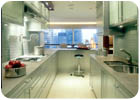
The French limestone countertops complement the Yellow Bulgarian limestone floor and serve as a counterbalance to the sleek aluminum cabinetry.
Complementing the quartzite are large-format, brown, Italian porcelain floor tiles. “We did some renovations of the existing portions of the house, including redoing the wood floors,†explained Rabinovitch. “We knew that we clearly wanted tile in the kitchen, and we also wanted something consistent in color to the wood.â€
The porcelain tiles measured 16 x 16 inches. According to the architect, the larger size was chosen to provide a better proportion with the oddly shaped space.
Further enhancing the kitchen design are the walls and backsplash, consisting of etched glass tiles that are each a little bigger than an inch square. “It is a beautiful balance with the green of the quartzite on the counters,†said Rabinovitch. “We were looking for something that would be practical. It really is a nice and more of a durable material. The luminous quality works nicely with the metal cabinets and appliances.†The same palette was also utilized in the redesign of the adjacent bar, dining and entry gallery areas, with the new non-kitchen cabinetry constructed of darkened white oak.
All in all, the project took about one year to complete. “Although the new and reconstructed areas - with their highly crafted finishes and assemblies - appear to stand in sharp position to the original house, the points of intersection between the two serve in fact to enhance their respective characteristics and beauty,†said Rabinovitch.
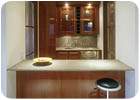
Additionally, French limestone was chosen for a countertop in the bar area.
A “Trump†Lifestyle
For another residence, Rabinovitch was faced with the challenge of creating two individual suites for two brothers residing within one living space in Manhattan's luxurious Trump Tower. And although his clients requested their own private areas, the residence also had to appear and function as one cohesive unit. To maintain consistency, the architect chose two types of Bulgarian limestone - supplied by Paris Ceramics - that were used in combination with each other as flooring throughout the 3,500-square-foot home.“This is an 'ultra luxury' apartment located on the 49th floor of Trump Tower, with sweeping vistas over Manhattan in three directions, and is in fact a combination of two adjacent apartments reconfigured into a fully integrated new living space,†said Rabinovitch. “Designed to create two master bedroom suites, the residence features these individualized areas at opposite ends of the space, connected by a common zone containing kitchen, entertaining, living and utility areas.â€
While the overall feel of the apartment is contemporary, the materials palette contains warm colors of stone and tile, which provide a comfortable and inviting atmosphere. “White Bulgarian limestone was used as a theme throughout the hallways and entry halls,†said the architect. “Bulgarian Yellow limestone was used as an accent material in the kitchen.â€
Additionally, the varying types of limestone were employed in conjunction with each other for a stone centerpiece in the entry foyer, which was custom fabricated by Paris Ceramics. “This is a visual focal point [of the residence],†explained Rabinovitch. “It has a classical feel, but in a contemporary way with muted colors. [The design is] echoed by a circular shape above in the ceiling, which is finished in a nickel-metal leaf material. The entry is the organizing anchor for the apartment.â€
Complementing the Bulgarian Yellow limestone flooring in the kitchen are countertops fabricated from a French limestone, Pompignon, supplied by Haifa Stone. Rabinovitch explained that the limestone features a Patina, which is a sandblasted finish. “The finish on the limestone was selected as a counterbalance for the cabinetry,†he said. “The aluminum is slick. The contemporary nature of that balances nicely with the rustic quality of the stone.†In addition, glass tile was employed for the backsplash. “It was chosen for its beauty, and it was [also] compatible with the cabinetry.â€
Continuing the use of stone, Indian Copper slate, supplied by Pet-Mal Inc. of Long Island, NY, was employed for the floors and walls in the guest powder room. “This was conceived as a dramatic, 'grotto'-like space,†said Rabinovitch. “Copper has been used as the prevailing material, and color of this room, such that all fixtures are copper-finished - faucet, wall mirror, sink base, etc.â€

In one of the master baths in the Trump Tower residence, cream-colored limestone tile and mosaic are contrasted with a “ming-green†mosaic tile accent on all wall surfaces, presenting a unifying visual element in relation to the varied wall surfaces and shapes. Verde Silver granite with a sandblasted finish was used for the countertops and tub decks. Stone Supplier: Haifa Stone (granite)
For one of the master baths, a graceful curved wall - with an upper section comprised of a formed strip of etched glass - encloses the space. “The etched glass serves to allow natural light to penetrate from the tower's glass exterior,†said Rabinovitch. “Cream-colored limestone tile and mosaic are contrasted with a 'ming-green' mosaic tile accent on all wall surfaces, presenting a unifying visual element in relation to the varied wall surfaces and shapes.†A mosaic border in the room was assembled in the form of a decorative wave motif.
“[The mosaic] is a classic type of pattern, but works in a contemporary space,†said the architect. “It is a fairly large bathroom. There are several chambers, and the band of mosaics is the continuous element that ties everything together. The green in there is a balance.â€
Verde Silver granite was used for the countertops and tub decks in the master bath. The material was given a sandblasted finish. “The other interesting element in [this master bath] is a trough-like sink, which was custom fabricated from Pietra Serena,†said Rabinovitch. “We couldn't get the granite, but the stone was so neutral in color; it worked with the other material.â€
In the second master bath, the owner desired a more unique look. “The color cobalt blue was chosen as a theme for this room to reflect the client's preference for the color,†said Rabinovitch. “It is used on the light fixtures, painted ceiling areas, and as a glass mosaic accent band inset on the otherwise neutral stone walls.†In total, it took about a year and a half to complete the renovation of the Trump Tower residence.
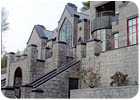
For a residence in Covington, VA, three varieties of granite were primary building materials in the construction of the home. Polychrome and Praire Green granite - both quarried in Canada - as well as Vanga Red granite from Sweden, were instrumental in creating a 5,000 square-foot vacation house, which sits on 350 acres of land. Rough and polished finishes were used in combination with each other, creating a dramatic contrast. Additionally, the bold rugged stone pieces on the lower portion of the home complement the rugged terrain on site. Architect: Brockwell Associates Inc., Durham, NC; Contractor/Owner: Hock Development, Durham, NC; Stone Quarrier/Fabricator: Granicor Inc., St. Augustin, Quebec, Canada
Southern Grandeur
While stone and tile are being utilized in many innovative ways throughout interior living spaces, these materials are also being used to enhance the aesthetic quality of residential exteriors. In particular, natural stone has the ability to create dimension and texture - boosting the overall value of a home.For a residence in Covington, VA, three varieties of granite were primary building materials in the construction of the home. Polychrome and Praire Green granite - both quarried in Canada - as well as Vanga Red granite from Sweden, were instrumental in creating a 5,000-square-foot vacation house, which sits on 350 acres of land. All of the granite was supplied and fabricated by Granicor Inc. of St. Augustin, Quebec, Canada.
“Bascially, it was a 'getaway' home,†said Architect Sam Brockwell of Brockwell Associates in Durham, NC. “There are three natural springs on the property, and it is on a trout stream.†The design concept for the home was to tie the structure with its natural setting, the architect explained. The granite played an essential role in achieving this objective.
“Using stone was a very early determinate,†said Brockwell. “We knew we wanted to use granite.†The architect went on to say that the homeowner is a contractor, and has always been a big proponent of granite.
“It's a combination of a fire-treated [finish] to give texture and polished,†said Brockwell. The bold rugged stone pieces on the lower portion of the home complement the rugged terrain on site. Additionally, the difference in textures creates a dramatic contrast. The abundant employment of stone anchored the residence to the ground, making a statement of permanence. It also went along with the other strong durable construction materials used to build the structure. “The house is non-combustible construction,†said the architect. “There is no wood. Everything is steel-stud tress.â€
Brockwell explained that the owner put a great deal of thought and time into building his home. With his contracting business, Hock Development, located in Durham, NC, he used many subcontractors from that area. The workers would drive the distance and spend several days in the area at a time to lay the stonework.
In the end, everything ran smoothly with the stonework, said Brockwell. The residence recently was recognized with a Pinnacle Award of Merit presented by the Marble Institute of America.
